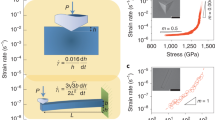Abstract
A number of transitions of state have been known for many years. Such are the sol-gel transitions and those which accompany the change of state of a vapour or a binary liquid mixture in the critical region. Others have been the subject of recent study in consequence of the industrial development of high polymers and thermo-plastics.Such are the vitreous transition of glycerine and the mesomorphic change in sulphur.
The author has been studying a number of these changes, measuring (a) viscosity (b) velocity and absorption of ultrasonic waves (c) attenuation of shear waves and relating these factors to the rheological properties in the change of state.
Zusammenfassung
Eine Reihe von Zustandsumwandlungen sind seit vielen Jahren bekannt, z. B. Sol-Gel-Übergänge und Zustandsänderungen von Gasen und binären flüssigen Mischungen im kritischen Gebiet. Andere sind Untersuchungsobjekt der letzten Zeit als Folge der steigenden technischen Bedeutung der Hochpolymeren und Thermoplaste geworden: glasige Erstarrung des Glyzerins, mesomorphe Umwandlungen von Schwefel.
Der Autor hat eine Anzahl dieser Umwandlungen untersucht, indem er a) die Viskosität, b) die Geschwindigkeit und Adsorption von Ultraschallwellen und c) die Dämpfung von Scherwellen gemessen und diese sämtlichen Fakten mit den rheologischen Eigenschaften während der Zustandsänderung verknüpft hat
Similar content being viewed by others
References
Richardson, E. G., Trans. Farad. Soc.29, 494 (1933).
Hastewell, L. J. andR. Roscoe, J. Sci. Inst.32, 96 (1955).
Weissenburg, K., Nature159, 310 (1947).
Richardson, E. G., Phil. Mag.36, 473 (1945).
Philipoff, W., Phys. Z.35, 885 (1934).
Mason, W. P. andH. J. McSkimin, Bell. Syst. Tech. J.31, 122 (1952).
Pryor, A. W. andE. G. Richardson, J. Phys. Chem.59, 14 (1955).
Subrahmanyam, S. V., J. Chem. Phys.22, 1562 (1954).
Krishnamurti, M., Nature174, 132 (1955).
Bordoni, P. G. andM. Nuovo, Coll. Ultrasonic (Brussels 1951) 164.
Parbrook, H. D. andE. G. Richardson, Proc. Phys. Soc. B65, 437 (1952).
Brown, A. E. andE. G. Richardson (unpublished)
Gabrielli, I. andL. Verdini, Nuovo Cimento2, 526 (1955).
Semenchenko, B. K. andE. H. Zorina, Proc. Acad. Sci. U. R. S. S.73, 331 (1950).
Schulz, A. K., Z. f. Naturforschg.9a, 944 (1954).
Litowitz, T. A. andD. Sette, J. Chem. Phys.21, 17 (1953).
Benbow, J. J. andD. J. C. Wood, Proc. Roy. Soc. A243, 518 (1958).
Author information
Authors and Affiliations
Rights and permissions
About this article
Cite this article
Richardson, E.G. The rheology of transitions. Rheol Acta 1, 251–257 (1958). https://doi.org/10.1007/BF01968877
Received:
Issue Date:
DOI: https://doi.org/10.1007/BF01968877




